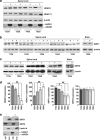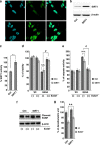Tissue-specific deregulation of selected HDACs characterizes ALS progression in mouse models: pharmacological characterization of SIRT1 and SIRT2 pathways
- PMID: 24946089
- PMCID: PMC4611720
- DOI: 10.1038/cddis.2014.247
Tissue-specific deregulation of selected HDACs characterizes ALS progression in mouse models: pharmacological characterization of SIRT1 and SIRT2 pathways
Abstract
Acetylation homeostasis is thought to play a role in amyotrophic lateral sclerosis, and treatment with inhibitors of histone deacetylases has been considered a potential and attractive therapeutic approach, despite the lack of a thorough study of this class of proteins. In this study, we have considerably extended previous knowledge on the expression of 13 histone deacetylases in tissues (spinal cord and muscle) from mice carrying two different ALS-linked SOD1 mutations (G93A-SOD1 and G86R-SOD1). We have then focused on class III histone deacetylases SIRT1 and SIRT2 that are considered relevant in neurodegenerative diseases. SIRT1 decreases in the spinal cord, but increases in muscle during the progression of the disease, and a similar expression pattern is observed in the corresponding cell models (neuroblastoma and myoblasts). SIRT2 mRNA expression increases in the spinal cord in both G93A-SOD1 and G86R-SOD1 mice but protein expression is substantially unchanged in all the models examined. At variance with other sirtuin modulators (sirtinol, AGK2 and SRT1720), the well-known SIRT1 inhibitor Ex527 has positive effects on survival of neuronal cells expressing mutant SOD1, but this effect is neither mediated by SIRT1 inhibition nor by SIRT2 inhibition. These data call for caution in proposing sirtuin modulation as a target for treatment.
Figures








Similar articles
-
Hdac6 deletion delays disease progression in the SOD1G93A mouse model of ALS.Hum Mol Genet. 2013 May 1;22(9):1783-90. doi: 10.1093/hmg/ddt028. Epub 2013 Jan 30. Hum Mol Genet. 2013. PMID: 23364049
-
Differential sirtuin expression patterns in amyotrophic lateral sclerosis (ALS) postmortem tissue: neuroprotective or neurotoxic properties of sirtuins in ALS?Neurodegener Dis. 2013;11(3):141-52. doi: 10.1159/000338048. Epub 2012 Jul 10. Neurodegener Dis. 2013. PMID: 22796962
-
SIRT1 overexpression ameliorates a mouse model of SOD1-linked amyotrophic lateral sclerosis via HSF1/HSP70i chaperone system.Mol Brain. 2014 Aug 29;7:62. doi: 10.1186/s13041-014-0062-1. Mol Brain. 2014. PMID: 25167838 Free PMC article.
-
Review of the anti-inflammatory effect of SIRT1 and SIRT2 modulators on neurodegenerative diseases.Eur J Pharmacol. 2020 Jan 15;867:172847. doi: 10.1016/j.ejphar.2019.172847. Epub 2019 Dec 5. Eur J Pharmacol. 2020. PMID: 31812544 Review.
-
Transgenic mouse model for familial amyotrophic lateral sclerosis with superoxide dismutase-1 mutation.Neuropathology. 2001 Mar;21(1):82-92. doi: 10.1046/j.1440-1789.2001.00361.x. Neuropathology. 2001. PMID: 11304046 Review.
Cited by
-
Biochemical mechanism and biological effects of the inhibition of silent information regulator 1 (SIRT1) by EX-527 (SEN0014196 or selisistat).J Enzyme Inhib Med Chem. 2020 Dec;35(1):1124-1136. doi: 10.1080/14756366.2020.1758691. J Enzyme Inhib Med Chem. 2020. PMID: 32366137 Free PMC article.
-
Roles of Aging, Circular RNAs, and RNA Editing in the Pathogenesis of Amyotrophic Lateral Sclerosis: Potential Biomarkers and Therapeutic Targets.Cells. 2023 May 22;12(10):1443. doi: 10.3390/cells12101443. Cells. 2023. PMID: 37408276 Free PMC article. Review.
-
The Essential Role of Epigenetic Modifications in Neurodegenerative Diseases with Dyskinesia.Cell Mol Neurobiol. 2022 Nov;42(8):2459-2472. doi: 10.1007/s10571-021-01133-z. Epub 2021 Aug 12. Cell Mol Neurobiol. 2022. PMID: 34383231 Free PMC article. Review.
-
Mitochondrial Dysfunction, Neurogenesis, and Epigenetics: Putative Implications for Amyotrophic Lateral Sclerosis Neurodegeneration and Treatment.Front Neurosci. 2020 Jul 15;14:679. doi: 10.3389/fnins.2020.00679. eCollection 2020. Front Neurosci. 2020. PMID: 32760239 Free PMC article. Review.
-
Oxidative stress and mitochondrial damage: importance in non-SOD1 ALS.Front Cell Neurosci. 2015 Feb 17;9:41. doi: 10.3389/fncel.2015.00041. eCollection 2015. Front Cell Neurosci. 2015. PMID: 25741238 Free PMC article. Review.
References
-
- 1Cozzolino M, Pesaresi MG, Gerbino V, Grosskreutz J, Carrì MT. Amyotrophic lateral sclerosis: new insights into underlying molecular mechanisms and opportunities for therapeutic intervention. Antioxid Redox Signal 2012; 17: 1277–1330. - PubMed
-
- 2Schmalbach S, Petri S. Histone deacetylation and motor neuron degeneration. CNS Neurol Disord Drug Targets 2010; 9: 279–284. - PubMed
-
- 5Rouaux C, Panteleeva I, René F, Gonzalez de Aguilar JL, Echaniz-Laguna A, Dupuis L et al. Sodium valproate exerts neuroprotective effects in vivo through CREB-binding protein-dependent mechanisms but does not improve survival in an amyotrophic lateral sclerosis mouse model. J Neurosci 2007; 27: 5535–5545. - PMC - PubMed
Publication types
MeSH terms
Substances
LinkOut - more resources
Full Text Sources
Other Literature Sources
Medical
Miscellaneous

